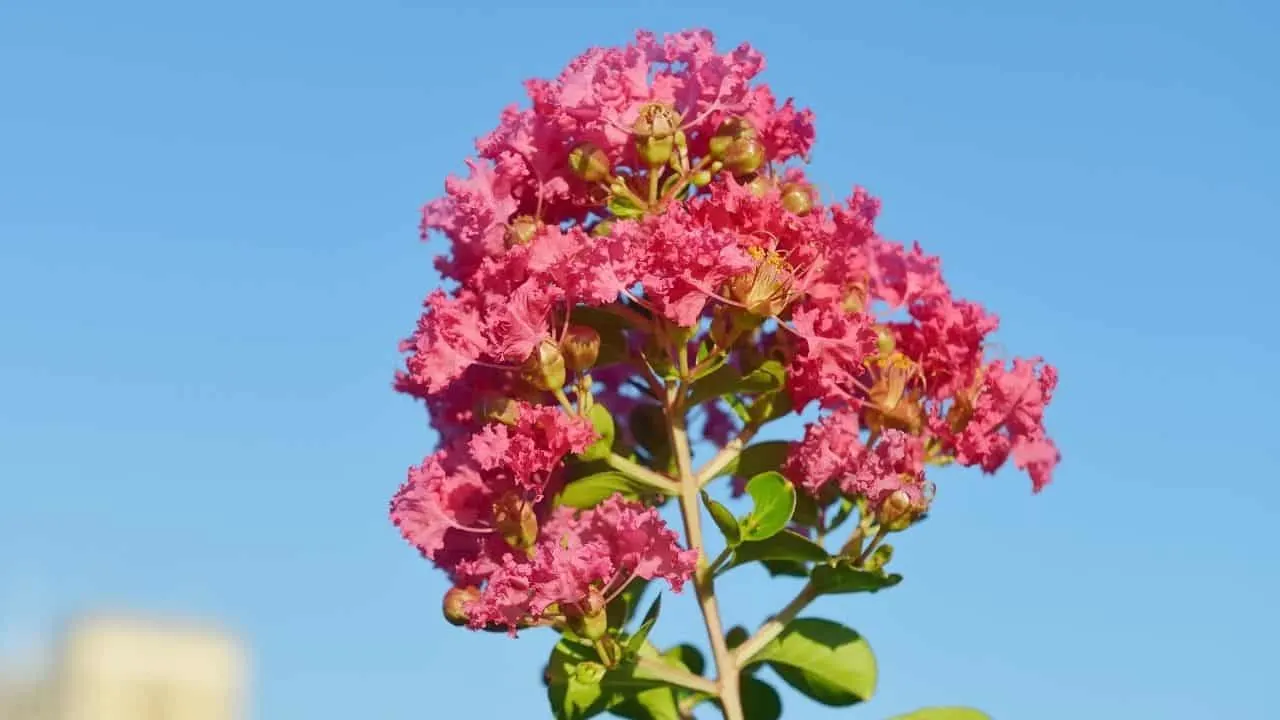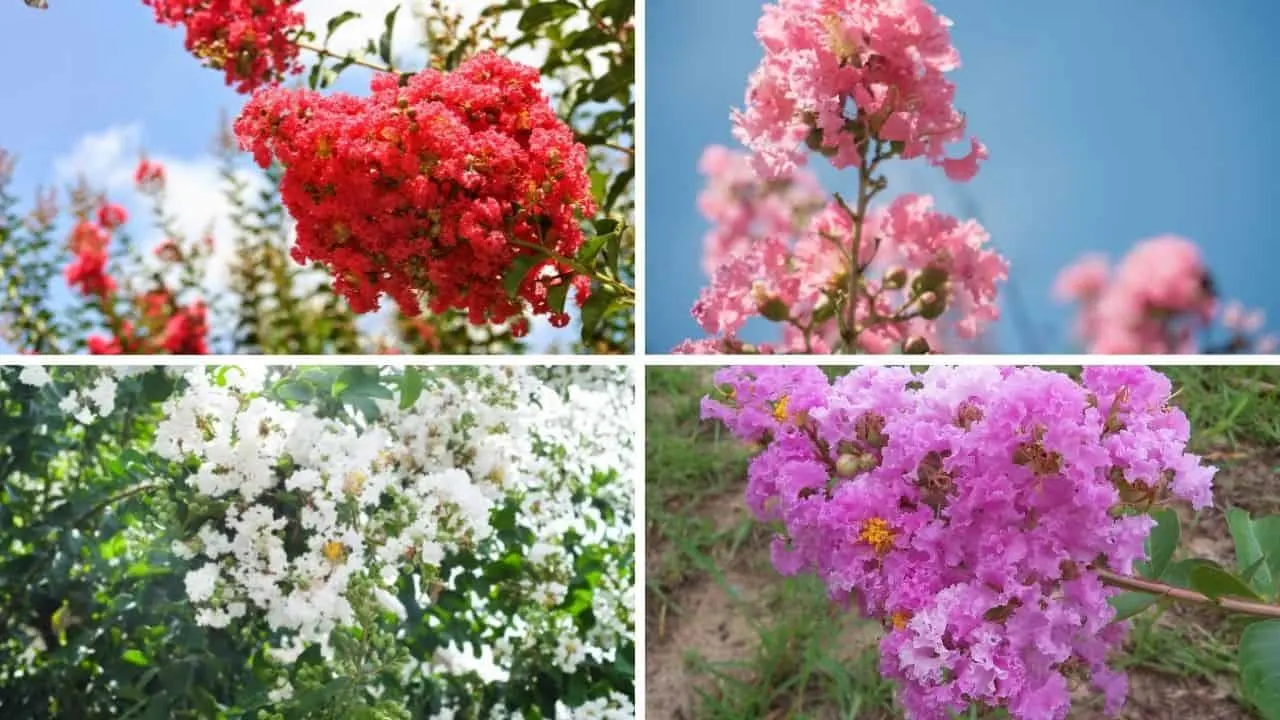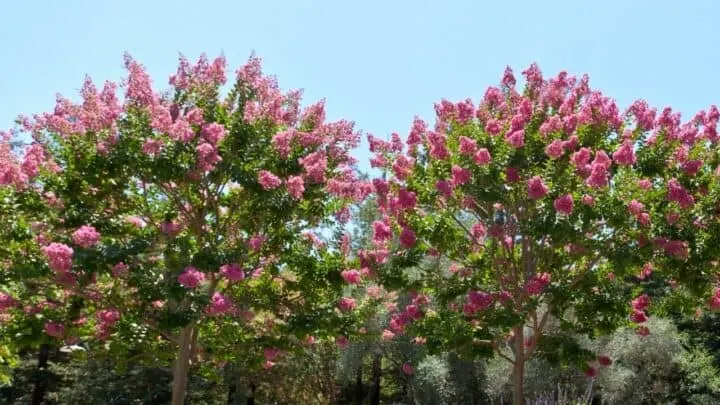Crepe Myrtle or Crape Myrtle (Lagerstroemia indica), often known as “Southern Lilacs,” are popular in the South and reach a height of up to 25 feet (7.6m) according to Missouri Botanical Gardens.
The main reason for their popularity is their stunning early spring blooms, brilliant autumn black leaves, and, in some cases, appealing bark.
Crape Myrtles grow best in tropical and subtropical climates, where the warm weather allows them to flourish and display their stunning beauty.
Table of Contents
Crepe Myrtle Takeaways
| Species | Lagerstroemia indica |
| Synonyms | Crepe myrtle, Crape Myrtle, Crepe flower |
| Family | Lythraceae |
| Genus | Lagerstroemia |
| Growth | Deciduous shrub |
| Height | 25 feet |
| Width | 15 feet |
| Soil | Well-draining soil. Loamy sand, clay |
| Watering | Water every 7 days |
| Light | Full sun |
| Temperature | 0 to 115°F |
| Humidity | 40-50% |
| Fertilizer | Fertilize monthly |
| Propagation | Semi-hardwood cuttings |
| Toxicity | Crepe myrtle is non-toxic to animals and humans |
Crepe Myrtle Care
To care for a crepe myrtle tree, provide well-draining soil using clay, loamy sand, and well-draining soil using loamy sand and clay. Plant it in a location that gets full sunlight. Water once a week during the growing season. Tolerates temperatures down to 0°F (-17.7°C) and up to 115°F (-46°C).

Crape Myrtle Growing Guide
Soil
The Crepe Myrtle tree will thrive in well-draining soil using loamy sand and clay. Keep the soil moist. Crepe Myrtle thrives in acidic to mildly acidic, with a pH of 5.0 to 6.5. Most gardening soil is between pH 6.0 to 7.0.
Water
The plant needs to be watered once a week to avoid wilting. Make sure to immerse the root system thoroughly with water, which takes around 45-60 minutes.
These trees require at least one inch of water per week for optimal development and yield. Water is required throughout drought periods. The key is to keep the ground from becoming soggy.
Otherwise, you are inviting root rot to take hold of your tree. Cultivating in well-draining soil can help prevent this.
Flowers may be harmed if they are not adequately watered in dry weather. Your tree will be spontaneously drought-resistant when it achieves maturity.
Gardeners use deep watering for this tree. This is when you irrigate for extended lengths of time on fewer days.
It guarantees that the tree gets the appropriate quantity of hydration while watering without being soggy.
Mulching the plant’s base will let it stay hydrated for longer.
Light
These trees require full sun. This tree doesn’t perform well in fully covered areas.

Temperature
Crepe Myrtle is generally cold-resistant to USDA Zone 7a, which means, it can withstand temperatures of around 0 degrees Fahrenheit (-17.7 degrees Celsius) in the wintertime.
Several newer types are now cold hardy down to USDA Zone 6a, with temperatures as low as -10 degrees Fahrenheit (-23.3 degrees Celsius).
This tree has long been considered a southern landscape classic, but with the advent of numerous fresh and more cold-tolerant Crepe Myrtle cultivars.
This tree can be grown in pots that can be overwintered in an indoor place where temperatures won’t fall under 20 degrees Fahrenheit (-6.6 degrees Celsius).
If you’re ready to take risks, you can grow these trees outside in Zone 6 all year around. Plant sections above ground may be injured or lost in the process.
Humidity
Crepe Myrtle trees thrive in moderate humidity levels between 40-50%. It does not like to stay in very high-humidity areas.
Fertilizer
Fertilize lightly twice per month throughout the spring and summer.
Reapply fertilizer around the root of the plant as it emerges from the dormant phase in the spring.
This will help provide a nutritional boost while also ensuring that any nutrients taken by the plant during the prior growing season are replaced.
Young trees require mild fertilizing once per month in the first spring or summer growth period.
Mature trees and shrubs profit from slow-release fertilizers sprayed at the first indications of new shoots in early spring.
After each fertilizer treatment, water thoroughly and add compost to preserve the roots during the winter.
Crepe Myrtle thrives on well-balanced garden fertilizers such as NPK 16-4-8, 12-4-8, 10-10-10, or 8-8-8. Excessive leaf development and poor flowering are the results of over-fertilization.
Repotting
The optimal time for repotting is late winter. You’ll have to wait until the soil is not frozen solid anymore. Repot before the first leaflets emerge.
For maximum flowering, choose a sunny position with plenty of space for the tree.
It takes some excavating to move these trees. Create a fresh transplanting hole.
It must be big enough to keep up all of the tree’s present roots but also broad enough to permit future growth. After that, you must dig out the tree.
The larger your tree, the more people you will need to assist you. Dig along the outside of the roots to create a 2 to 3-foot (6-.9 m) wide rootball.
Transplant the root ball into the soil, making sure it is even in the soil. Add plenty of water to the root area and keep watering for the first growing season.
Pruning
Pruning isn’t necessary. Some gardeners prune every year; however, this distorts their native form and attractiveness.
Trim any sucker sprouts that grow near the base of the tree. Always prune trees to contour them or remove any cross branches.
You can get rid of old seedpods by pruning the tops of stems in the winter.
Three tools required to trim a grown tree are:
- Hand pruners to trim the branches and twigs that are less than ½ inch thick.
- Loppers for ½-inch to 1-inch thick branches.
- Pole pruners for branches thicker than ½ inch.
Late winter is the perfect season to trim a Crape Myrtle as it is dormant during that period.
Pruning now will not diminish flowering because it flowers on new shoots. In fact, it has the potential to grow it.
To prune your plant:
- Start with the suckers that come out from the base of the tree.
- The side branches that are longer than 4 feet should also be trimmed.
- The tall branches are developing towards the center of the Crepe Myrtle.
- Dead, crossing, and rubbing branches also need to be trimmed away.
- The branches that appear in a weird shape deteriorating their appearance should be pruned right away.
It’s crucial not to trim the crowns of these trees in order to encourage them to flower. Although topping produces larger blooms, it has little effect on the overall number of flowers.

Extreme topping frequently produces sluggish growth that bends or breaks during rainfall.
Crape Myrtle Propagation
Root Cuttings
Crepe Myrtle can be propagated through root cuttings. Start digging up a mature ree in the springtime.
Remove a section of the roots with a paring blade or scissors. Put the tree back into its original location once you’ve taken a root cutting.
In a container with good soil or dirt, insert the cutting. The container should be put in a warm location with bright indirect light.
Give the roots plenty of water for the next few weeks until they form their own root systems.
Allow the roots to settle in the containers for about 2-3 months until the cutting is fully rooted. Then you can transplant the new tree to its final location.
Another alternative is to plant the root cuttings into their permanent location immediately. Bury the roots four inches deep in the soil, with a six-inch gap between every root cutting.
The root cuttings will form a root system and become mature plants over time. Ensure the plant’s roots get enough water as they continue growing.
Propagate using a semi-hardwood cutting
Take a look at a mature Crepe Myrtle. Find the point where the tree’s new shoots, that contain nodes, meet an older branch.
Trim it where it touches the branch, keeping the cutting length around six and seven inches.
Each cutting should have at least three nodes. Only four leaves should be left on the cutting. Discard the remaining items.
Put the cutting in a sand-filled container after dipping it in the rooting hormone. During the next 2 to 3 months, give enough sunlight, heat, and moisture.
After this time frame, the cutting should have formed a root system and be prepared to transfer into a bigger pot or perennial bed.
Crepe Myrtle Blooms
Crape Myrtles flower from July through September. Certain varieties produce flowers until the first frost hits. You will find the flowers of this tree in several different colors ranging from red, pink, white, and purple.

Crepe Myrtle Growth
Standard single-trunk and multi-trunk trees can reach 20 to 30 feet (6-9 meters) tall and 10 to 15 feet (3-4.5 meters) broad, with annual growth rates of up to 3 feet (1 meter).
Then there are dwarf shrubs 2 to 5 feet tall (0.6-1.5 meters), semi-dwarf shrubs 3 to 6 (1-1.8 meters) feet long, and smaller variants 6 to 12 feet (1.8-3.6 meters) feet tall.
Make certain you select the right Crepe Myrtle shrub or tree for your area and style.
Common Problems for Crepe Myrtle Trees
Aphids
The light-yellow aphids can be found on the undersides of Crepe Myrtle foliage, draining sap from the tree and causing harm.
Aphids also generate adhesive honeydew drips that cling to the tree and neighboring patios and furniture.
Predators, such as ladybugs, keep these insects in check. If you use insecticides, the hunters may be killed instead of the aphids.
Stop applying pesticides and add some ladybugs. The prey population should expand, and the aphids will be eaten.
If it doesn’t help, try using an insecticidal soap or an oil product like Neem Oil Spray or paraffinic oil to spray your tree.
Powdery Mildew
Although there are a few robust types, these trees are mildew-prone according to Clemson University.
Powdery mildew can be identified by a grey or white powdery deposit on the foliage and bloom buds of your plant.
A fungal disease affects trees by interrupting photosynthesis and other key life functions in their leaves and flowers.
It can be treated with any fungicide labeled for mildew and applied weekly till the bud blooms.
Furthermore, cutting off branches to promote sun and airflow entry into the canopy can assist lessen mildew vulnerability.
Cercospora leaf spot
Cercospora leaf spot is a fungal disease that turns the leaves of Crepe Myrtle trees orange, yellow and red. It starts with black spots and will then discolor the leaves. Finally, the leaves will fall off. The cause is humid conditions caused by heavy rainfall.
You can use a copper-based fungicide to treat your tree. However, it is best to take preventative measures and make sure the tree gets sufficient airflow to its leaves. Whenever you water ensure that you are not spraying your plants’ leaves.
Curling leaves
Curling leaves are caused by many different reasons such as too much fertilizer, pesticides, pests, and viruses as well as inadequate conditions.
Identify the reason that most likely caused the curling leaves on the Crepe Myrtle to remedy the situation.
Brown Leaves
Brown leaves on a Crape Myrtle tree can occur naturally because of the change of season. But brown leaves can also have many other reasons such as diseases such as fungal infections, pests as well as overfertilization, and underwatering.
Black Leaves
The reason for black leaves is a fungus. The culprit is called sooty mold. To get rid of the problem use a systemic insecticide to get rid of bugs such as aphids. Pests like aphids produce honeydew that leads to sooty mold. Read more about how to treat black leaves on a Crepe flower here.
White Spots on Leaves
White spots on the leaves of a Myrtle tree are caused by powdery mildew or poor ventilation if they emerge on the bark of the tree. Additional reasons can be bark scale if the tree is pruned insufficiently.
Read more about the causes and remedies here.
Yellow leaves
The most common reason for yellow leave is autumn as these trees are deciduous and will lose their leaves in autumn. However, there are also more severe reasons for yellow leaves from under to overwatering to pests as well as diseases and toxins building up.
If your tree develops yellow leaves and autumn is not to blame for it, read this guide.
Crape Myrtle Does not Flower
If the Crape Myrtle does not flower, the reason could be insufficient sunlight. These trees need at least 6 hours of direct sunlight to bloom. Make sure that your plant is not too crowded.
Ensure that your tree is getting enough fertilizer. A nitrogen-rich fertilizer should be applied in late winter or early spring. Never prune before the flowering season.
Tips for Growing a Crepe Myrtle Tree
- Always disinfect your pruning shears to avoid the spread of infections.
- Always place it in a spot that is sunny and warm for optimal flower growth.
- Water it thoroughly during the first few weeks of the growth period.
Read about the best plants under a Crepe Myrtle tree next.
Frequently Asked Questions about Crepe Myrtle Tree Care
How long does a Crepe Myrtle live?
A Crepe Myrtle can live for about 50 years or more.
Does a Crepe Myrtle need lots of water?
Crepe Myrtle requires at least one inch of water per week for optimal development and yield. Water is required throughout dry periods. Flowers may be harmed if they are not adequately watered during dry weather.
Conclusion About Crepe Myrtle Care
- Light: full sunlight
- Soil: Well-draining soil with a pH of 5.0 to 6.5
- Water: Once a week
- Hardiness: Grows in USDA zone 6 to 9
- Humidity: 40-50%
- Fertilizer: Monthly
- Pruning: From late winter to spring

Daniel has been a plant enthusiast for over 20 years. He owns hundreds of houseplants and prepares for the chili growing seasons yearly with great anticipation. His favorite plants are plant species in the Araceae family, such as Monstera, Philodendron, and Anthurium. He also loves gardening and is growing hot peppers, tomatoes, and many more vegetables.


